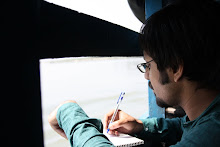Nowhere Boy
I had high hopes for
Nowhere Boy, the debut feature from the talented British filmmaker Sam Taylor Wood.The reviews were great, and most people thought that she'd done a credible job with the highly movie-worthy childhood of St John. It was a dissapointment, and not because I'm a fan. In fact, the fan in me quite liked the way Taylor Wood didn't play fast and loose with the source material, refrained from painting characters in an unidimensional hue, and largely kept the pace from flagging. But here's the thing- it lacks a certain grit. Grit that's not just the
de rigueur of every rock biopic worth its salt nowadays from
I'm Not Here to
Control, but one that's necessary to tell a credible story. Forget the fact that Adam Johnson- who plays a teenage Lennon credibly enough- is far too beefy for a 16 year old, or that Lennon isn't even the real focus of the movie- its his mother and aunt. What irked me most was the shiny nature of the movie. Certainly the world that this cinematic Lennon occupies is not the dying, decaying Liverpool that the Beatles so memorably mythologised. No, this is an idealised world of neat suburbanness, the same vision that so blighted the immensely forgettable movie on the 60's,
Across the Universe. This is even more surprising since she shares a screenplay writer with the superb
Control, another story about a tortured rock genius, from two years ago. I wonder if the 50's are too far removed from her for her to imagine it realistically. Kristin Scott Thomas as Aunty Mimi really steals the show though. Although she overdoes Mimi's poshness, she's the beating heart of this movie. The definitive Lennon movie is still to be made.
The Confessions of Robert Crumb
Move over Woody Allen. If there's a tortured, repressed genius with oversized glasses and a penchant for playing music, its the graphic novelist Robert Crumb. This delightful little self portrait from 1987 is as warm as it is funny. We all know about R Crumb the iconoclast and counterculture hero. Here we get a sneak peek into the mind of the man himself, beyond all the parody, and cheap shots, and prurient humour and enraged feminists. A truly subversive artist takes a look at his life, and you get a glimpse of what America has the potential for, rather than what it is.
Onibaba
My friend Kingshuk is an inveterate collector. This brilliant man is currently close to mortgaging his life to build up a pretty unique LP collection, but before all that started, he was a movie collector. Still is actually. So when he gave a few DVDs of cult Japanese horror films to another friend of mine, I couldn't help but eye them furtively. Then I got him drunk and managed to sneak away the first one I could lay my hands on. It turned out to be the 1964 movie
Onibaba (Demon-Woman) by the director Kaneto Shindo. It has to be one of the most atmospheric films I've ever seen, right up there with
Night and the City and
Jalsaghar. This isn't a horror story in the strict sense of the term. I'd rather call it a passion play, much like many other Japanese classics of the era. Its a bonfire of outsized emotions literally running amok. It tells the story of three peasants in war-torn medieval Japan, and the chaos that's caused by the coming together of those two very potent urges- lust and hunger. It takes time to build, gradually setting the scene in a phantasmagoric world of rustling reeds. If there's anything that's haunted in this movie, its the land itself. And the sexuality of the movie has a force that has to be seen to be believed. I had no clue that the profoundly conservative Japanese society had room for such frankness in the 60's. Quite brilliant.
Che
Steve Soderbergh is a strange guy. He'll make cartloads of crappy Hollywood fillers like the Ocean's Eleven movies, and about once a decade spring a stunner. This decade, its got to be
Che, his biopic on Ernesto Guevara in two parts. I saw the first one yesterday, and I think Benicio Del Toro is God. He's truly brilliant in a way few good actors are. He never plays himself. In fact he never plays the same person twice. His Che is a profoundly different creature from say, his Dr Gonzo in
Fear and Loathing in Las Vegas, or the bitter Mexican policeman in
Traffic.
As a movie,
Che is remarkably un-Hollywood. No final payoffs, no unnecessary deification, and on top of that, the black and white format does it immense justice. This movie covers the successful period of the Commandante's revolutionary career. The sheer impossibility of the task that Fidel Castro and his bunch of merry men set themselves is nothing short of an intensely romantic adventure. The movie captures this well, but it gives us a fuller picture of the intense difficulties involved. To top it all, its shot on location in Cuba, which has to be one of the most gorgeous places on earth. It made me think how of its time the Cuban revolution was. Back then, the military-industrial nexus of the Capitalist west was very obvious in its methods- something that called for a certain approach to counter it. 40 years later, their modus operandi's very different. I wonder how the left movement will answer such threats now? I'm looking forward to the next instalment.






































